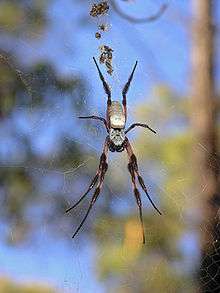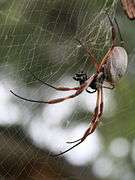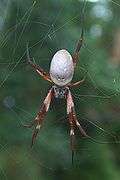Trichonephila edulis
Trichonephila edulis is a species of large spider of the family Araneidae, formerly placed in the genus Nephila. It is referred to the common name Australian golden orb weaver.[3] It is found in Australia, in both tropical and temperate regions, and in parts of New Guinea and New Caledonia.
| Trichonephila edulis | |
|---|---|
 | |
| Female Trichonephila edulis, Perth, Western Australia.[1] | |
| Scientific classification | |
| Kingdom: | Animalia |
| Phylum: | Arthropoda |
| Subphylum: | Chelicerata |
| Class: | Arachnida |
| Order: | Araneae |
| Infraorder: | Araneomorphae |
| Family: | Araneidae |
| Genus: | Trichonephila |
| Species: | T. edulis |
| Binomial name | |
| Trichonephila edulis (Labillardière, 1799)[2] | |
 | |
| Synonyms | |
|
Aranea edulis | |
It has a large body size variability, females can reach a body length of up to 40 millimetres, males about 7 mm. The cephalothorax is black with a white pattern on the back, and a yellow underside; the abdomen is grey to brown.
The web is about 1 metre in diameter and protected on one or both sides by a strong "barrier" web. T. edulis breeds from February to May, and produces an average of 380 eggs.
Name
The species was first collected and named by Jacques Labillardiere, in Relation du Voyage à la Recherche de la Pérouse (1799),[4] becoming the second Australian spider to be described by a European naturalist.[5] The first was Gasteracantha fornicata.
The species name edulis means "edible" in Latin. Labillardiere wrote: "Les habitans de la Nouvelle-Calédonie appellent nougui cette espèce d'araignée, que je désigne sous le nom d' aranea edulis (araignée que les Calédoniens mangent)." (The inhabitants of New Caledonia call this spider "nougui". I have described it under the name Aranea edulis, meaning spiders that the New Caledonians eat.)
Several related spiders are considered a delicacy in New Guinea, "plucked by the legs from their webs and lightly roasted over an open fire".[6]
Further reading
- Uhl, G. & Vollrath, F (2000). Extreme body size variability in the golden silk spider (Nephila edulis) does not extend to genitalia. J. Zool. Lond. 251:7-14 PDF
- Vollrath, F., Madsen, B. & Shao, Z. (2001). The effect of spinning conditions on the mechanics of a spider's dragline silk. Proceedings of the Royal Society B: Biological Sciences 268:2339-2346 PDF doi:10.1098/rspb.2001.1590
References
- Golden orb weavers Ed Nieuwenhuys, Ronald Loggen 1997, 2002, Jurgen Otto 2005. Retrieved 2007-04-07.
- "Taxon details Trichonephila edulis (Labillardiere, 1799)". World Spider Catalog. Natural History Museum Bern. Retrieved 2020-04-29.
- arachne.org.au http://www.arachne.org.au
- Labillardière, J. 1799. Relation du voyage à la recherche de La Pérouse, fait par ordre de l'Assemblée constituante. Paris Vol. 2 pp. 240-241
- Davies, Valerie Todd; et al. (30 Mar 2006). "Order Araneae: Spiders". Australian Faunal Directory. Government of Australia. Retrieved 2009-03-06.
- Meyer Rochow, V.B. (1973). Edible insects in three different ethnic groups of Papua and New Guinea. Am J. Clin. Nutr. 26:673-677.
Gallery
 Side view, Sydney female
Side view, Sydney female Back view, Sydney female
Back view, Sydney female Bottom view, Sydney female
Bottom view, Sydney female- Back view, Western Australia female
- A Queensland female and a locust fight in its web
External links

- Pictures and info
- The Food Insect Newsletter, July 1993